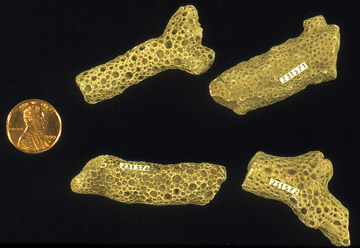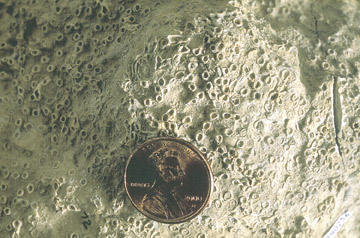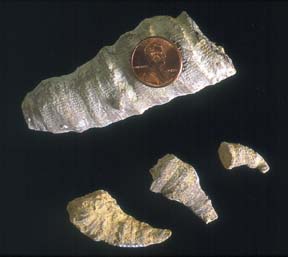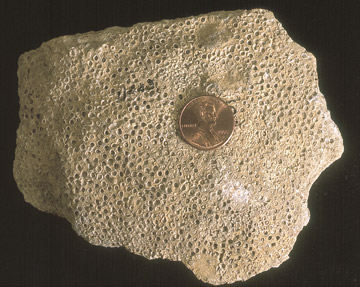Corals

Corals are simple animals that secrete skeletons made of calcium carbonate. They are close relatives of sea anemones and jellyfish and are the main reef builders in modern oceans. Corals can be either colonial or solitary.
As fossils, corals are found worldwide in sedimentary rocks. Based on these fossils, we know that the corals began their long evolutionary history in the Middle Cambrian, more than 510 million years ago. In Kansas, they are fairly common in Pennsylvanian and Permian rocks, deposited from about 323 to 252 million years ago.
Modern corals inhabit deep-water environments as well as shallow reefs. Based on evidence from the rocks, scientists have determined that the Pennsylvanian and Permian corals of Kansas lived in warm, shallow, sunlit waters where the bottom was firm enough to offer a secure point of attachment.
Two groups of corals were important inhabitants of the Pennsylvanian and Permian seas—tabulate and rugose corals. Tabulate corals were exclusively colonial and produced calcium carbonate skeletons in a variety of shapes: moundlike, sheetlike, chainlike, or branching. Tabulate corals get their name from horizontal internal partitions known as tabulae. Some tabulate corals were probably reef builders (but not in Kansas).

A common characteristic of rugose corals, from which they get their name, is the wrinkled appearance of their outer surface. (Rugose comes from the Latin word for wrinkled.) Rugose corals may be either solitary or colonial. Because solitary rugose corals are commonly shaped like a horn, these fossils are sometimes called horn corals.
Both tabulate and rugose corals died out in the major extinction that occurred at the end of the Permian Period, roughly 252 million years ago. This extinction marked the end of the Paleozoic Era. The corals that inhabited the post-Paleozoic seas differ significantly from the earlier corals. Because of this, many specialists argue that these later corals may not be closely related to the Paleozoic corals.
Tabulate and rugose corals are common in eastern Kansas. Rugose corals are especially common in the Beil Limestone Member of the Lecompton Limestone in the vicinity of Sedan, Kansas.


Stratigraphic Range: Middle Cambrian to Holocene.
Taxonomic Classification: Corals belong to the Kingdom Animalia, Phylum Cnidaria, Class Anthozoa, Subclass Zoantharia. The subclass is divided into six orders, two of which—the Rugosa and Tabulata—are common Kansas fossils. Most living and post-Paleozoic fossil corals belong to a third order, the Scleractinia, the earliest fossils of which are from the Triassic Period, 14 million years after the end-Permian mass extinction.
Text and photos from Windows to the Past: A Guidebook to Common Invertebrate Fossils of Kansas, Kansas Geological Survey Educational Series 16.
Sources
Boardman, R. S., Cheetham, A. H., and Rowell, A. J., 1987, Fossil Invertebrates: Boston, Blackwell Scientific Publications, 713 p.
Clarkson, E. N. K., 1979, Invertebrate Palaeontology and Evolution, 3rd Edition: London, Chapman and Hall, 434 p.
Fortey, R., 1999, Life—A Natural History of the First Four Billion Years of Life on Earth: New York, Knopf, 346 p.
Hill, D., 1981, Coelenterata, Anthozoa, Subclasses Rugosa and Tabulata; in, Treatise on Invertebrate Paleontology, Coelenterata, Supplement 1 (Rugosa and Tabulata), Part F, v. 1-2, Teichert, C., ed.: Boulder, Colorado, and Lawrence, Kansas, Geological Society of America and The University of Kansas, 762 p.
Johnson, K. B., and Stuckey, R. K., 1995, Prehistoric Journey—A History of Life on Earth: Boulder, Colorado, Denver Museum of Natural History and Roberts Rinehart Publishers, 144 p.
Moore, R. C., Lalicker, C. G., and Fischer, A. G., 1952, Invertebrate Fossils: New York, McGraw-Hill Book Co., 766 p.
Stanley, G. D., Jr., and Fautin, D. G., 2001, The Origins of Modern Corals: Science, v. 291, p. 1913-14.
University of California Museum of Paleontology, 1994, Introduction to the Tabulata (4/12/00).
University of California Museum of Paleontology, 1994, Introduction to the Scleractinia (4/12/00).
University of Newcastle, Department of Geology, 1998, Rugose and Tabulate Corals (Dec/24/03).